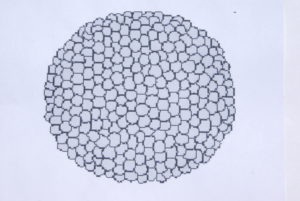Scientific atoms are basically empty open structure, has no mechanical support for nuclei and circling electrons, therefore it can’t be naturally evolved source for the solid matter.
Also the electron cells have no mechanical structure, nor does the nucleus give any structural support, because it’s sort of floating in the open space in the middle of circling electrons. In mechanical sense, the insignificant mass of five circling electrons separate each atom, everywhere the matter exists. What’s more, in order to get a visual idea of the atoms’ emptiness, consider this: If a nucleus is a tiny pencil dot, then the electrons are circling some three long steps away from the nucleus. So, its not possible for such empty atoms to stay together without getting crushed inside Earth’s molten core, because the core of each planet is under extremely high pressure including the Sun, and so does Earth, which generates an internal temperature near 5000 C. Hence, a scientific atom has no chance to exist in such environment as planet Earth has. In fact atoms evolve when the crusts of planet Earth has cooled down until a thick surface layer allows mass particles to begin to accumulate into atoms of various size. As expressed before, the mass-bit-particle is a solid object that cannot be destroyed by any means, and because the Milky Way galaxy evolved strictly from the primeval mass-bit-particles, thus all Stars we observe are made of mass-particles only. In conclusion, these lightweight scientific atoms don’t seem like a good idea, and most importantly abiotic nature has no resources to make such atoms at any state the matter

